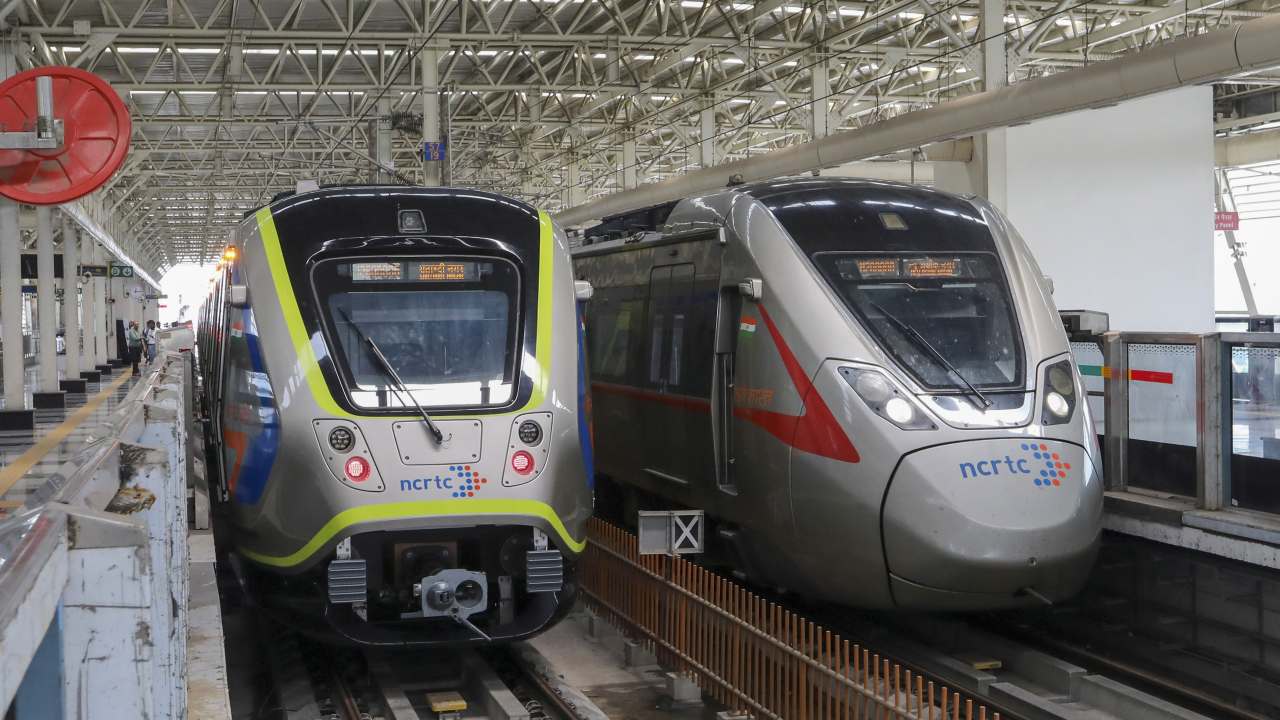What is the story about?
The Namo Bharat train, operating on the 55-km stretch of the Delhi-Meerut Regional Rapid Transit System (RRTS), has emerged as the fastest train in India, clocking a top speed of 160 kilometres per hour (kmph).
Until now, the Gatiman Express, introduced in 2016, held the distinction as the country's first semi-high-speed train, also reaching 160 kmph on the specially prepared Hazrat Nizamuddin-Agra route. The Vande Bharat series, launched later, matched that maximum speed, but only on this corridor. However, on June 24, 2024, the Railway Ministry reduced the permissible limit for all such trains from 160 kmph to 130 kmph without citing specific reasons. At present, trains across the national network run with an upper speed cap of 130 kmph.
Namo Bharat currently operates 30 trainsets of six coaches each, with services running every 15 minutes between New Ashok Nagar in Delhi and Meerut South in Uttar Pradesh. The train reaches its maximum speed briefly between some of the 11 stations on the operational section.
Also read | This iconic tourist landmark in Delhi is attracting more visitors thanks to its boating service
"The entire 82.15 km long corridor with 16 stations, starting from Sarai Kale Khan in Delhi to Modipuram in Uttar Pradesh, is likely to be
commissioned soon," officials from the National Capital Regional Transport Corporation Limited (NCRTC) said.
NCRTC, a joint venture between the Government of India (50%) and the state governments of Delhi, Uttar Pradesh, Haryana and Rajasthan (12.5%), is implementing India's first RRTS project.
"Designed in Hyderabad and manufactured at an Alstom factory located in Gujarat's Savli, the aerodynamic rolling stock, with their sleek and modern design, are compatible with Automatic Train Protection (ATP), Automatic Train Control
(ATC), and Automatic Train Operations (ATO)," officials explained, according to PTI.
They added, "The distance between two stations varies from five to eight kms and the train touches its highest speed between stations with longer distances."
Also read | How tourism in India's land of blue mountains will get a boost soon
According to an NCRTC release, once the entire corridor is open, Namo Bharat will connect Delhi with central Meerut in under an hour while halting at all intermediate stations. "Since the beginning of operations
on the 17 km long Priority Section on October 21, 2023, services have been commissioned on a 55-km stretch of the corridor in a phased manner," it noted.
"As the operational section has expanded, it has solidified its position as an essential transportation solution for the region and has successfully served more than 1.5 crore riders to date," the statement added.
Officials highlighted that the RRTS is distinct from both conventional rail and metro systems. "This system is different from conventional Railway as it
does not operate on a fixed timetable or require a seat reservation. It is also different from the metro transit service as it is catering to passengers looking to travel relatively longer distances with fewer stops and at a higher speed," they explained.
Until now, the Gatiman Express, introduced in 2016, held the distinction as the country's first semi-high-speed train, also reaching 160 kmph on the specially prepared Hazrat Nizamuddin-Agra route. The Vande Bharat series, launched later, matched that maximum speed, but only on this corridor. However, on June 24, 2024, the Railway Ministry reduced the permissible limit for all such trains from 160 kmph to 130 kmph without citing specific reasons. At present, trains across the national network run with an upper speed cap of 130 kmph.
Namo Bharat currently operates 30 trainsets of six coaches each, with services running every 15 minutes between New Ashok Nagar in Delhi and Meerut South in Uttar Pradesh. The train reaches its maximum speed briefly between some of the 11 stations on the operational section.
Also read | This iconic tourist landmark in Delhi is attracting more visitors thanks to its boating service
"The entire 82.15 km long corridor with 16 stations, starting from Sarai Kale Khan in Delhi to Modipuram in Uttar Pradesh, is likely to be
NCRTC, a joint venture between the Government of India (50%) and the state governments of Delhi, Uttar Pradesh, Haryana and Rajasthan (12.5%), is implementing India's first RRTS project.
"Designed in Hyderabad and manufactured at an Alstom factory located in Gujarat's Savli, the aerodynamic rolling stock, with their sleek and modern design, are compatible with Automatic Train Protection (ATP), Automatic Train Control
They added, "The distance between two stations varies from five to eight kms and the train touches its highest speed between stations with longer distances."
Also read | How tourism in India's land of blue mountains will get a boost soon
According to an NCRTC release, once the entire corridor is open, Namo Bharat will connect Delhi with central Meerut in under an hour while halting at all intermediate stations. "Since the beginning of operations
"As the operational section has expanded, it has solidified its position as an essential transportation solution for the region and has successfully served more than 1.5 crore riders to date," the statement added.
Officials highlighted that the RRTS is distinct from both conventional rail and metro systems. "This system is different from conventional Railway as it
Do you find this article useful?












